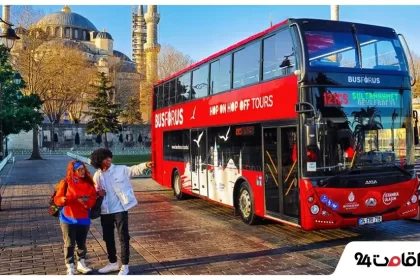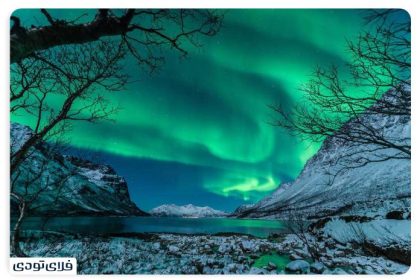If you are a tourist in Iran, you might ask yourself where to go in Zanjan? The sights of Zanjan are diverse and attractive, which will make your trip memorable. Zanjan is considered one of the old cities, and for this reason, the old texture of the city is full of historical monuments and works of art left from the past. In this article, we introduce the attractions of this beautiful city. Stay with us.
Introducing Zanjan
Zanjan city is the capital of Zanjan province in the northwest of Iran. This city has mild summers and cold winters. There are many natural and historical attractions in this city that you can enjoy. Zanjan was founded during the time of Ardeshir Babakan, the founder of the Sasanian dynasty, and was originally called “Shahin” or “Sahine”. Over time, this name was changed to “Zangan” and later to “Zanjan”. The history, pristine nature and tourist attractions of Zanjan have made it a spectacular and attractive city.
Sightseeing places in Zanjan
1. Soltanieh Dome
The Soltanieh dome was built during the reign of Sultan Muhammad Khodabandeh (712-704 AH). This building is one of the most magnificent Iranian architectures, which has 8 high porticoes and it is said that they were inspired by the 8 doors of heaven. The weight of the dome is 200 tons and it is placed on columns with an area of 50 square meters. Soltanieh Dome represents the art of that era. In this structure, you can see attractive inlays, plastering, painting and tiling, all of which are in harmony with each other. Verses from the Holy Qur’an are also written in thulth and kufi script in different parts of this building, which is very eye-catching.
The Soltanieh dome has 3 main parts: the dome room, the cellar and the terracotta house. You can see the most decorations in the interior of the dome room. The dome of this building consists of 2 shells with a height of 50 meters and therefore it is resistant to earthquakes. They have also designed some skylights in this area, which were used to tell the time in that era and were used as clocks. The cellar is in the southern part of the building and under the tomb, where Sultan Mohammad Khodabande was buried. The entrance to this area is low so that people approach the tomb with respect when entering this area.
Turbetkhaneh is also built on the south side of the building with a length of 17 meters, a width of 8 meters and a height of 16 meters. This part is known as Torbetkhaneh, because on the wall of the mihrab, verses from the Qur’an are written in Kufic and Thult script with the soil of the shrine of Hossein bin Ali (AS).
Address: Zanjan to Qazvin road, Soltanieh
2. Zanjan market

The old bazaar is one of the famous places in Zanjan, which dates back to the time of Agha Mohammad Khan Qajar. This market consists of 2 upper and lower market segments. In the lower market, in addition to local goods, they also sell goods from nearby villages. There are 2 local caravanserais named Sarai Malek and Sarai Golshan in this market, which were repaired and renovated in 1345. Agha Sheikh Fayaz Mosque and Mirza Mosque are among the other attractions of the bazaar, along with 2 public baths. The market building has been designed according to the weather conditions of Zanjan; For example, the architecture of the roof of the bazaar is thermal insulation and prevents the penetration of cold.
Zanjan market has a total of 940 shops, which are located in 8 parts. Each section is related to a specific trade and gold and jewelry, textiles, and fruit are sold in this market.
Address: Zanjan city, at the end of Saadi St., Elkhebal square
3. Zanjan Museum of Anthropology

The Museum of Anthropology is located in the historical mansion of the Zanjan Laundry. This museum is a relic of the Qajar era, when women used to wash clothes in its covered structure. The historical building of the laundry was built by 2 brothers named Mashhadi Akbar and Mashhadi Ismail in the historical context of Zanjan city. Stone, wood and brick have been used in this building and its architecture is very beautiful and unique. They have used stone in the design of the inner parts, which has great strength and does not have any problems in contact with water. The exterior is also covered with straw, which is thermal insulation. There are skylights on the roof of this building, which were used to distinguish religious times.
Address: Zanjan city, Saadi St., Rakhtoshoikhaneh alley
4. Katlekhor Cave

Katlekhor cave is one of the natural attractions of this city, 140 km away from Zanjan, on the slopes of the Sqizlu mountain range. Katlekhor means mountain of the sun; The reason for this name is that the sun rises from behind this mountain. The entrance to the cave is about 6 to 8 meters. Katlekhor is the deepest cave in Iran. The length of this cave is 13 kilometers and the time of its creation is estimated to be more than 100 million years ago.
Conical limestone deposits hang from the ceiling of this cave, which have attractive colors and make this cave an attractive place to watch the greatness of nature. Katlekhor Cave is not only geologically amazing but also has archaeological significance. In the excavations inside the cave, ancient artifacts such as pottery and stone tools have been discovered, which shows that humans lived in this area in ancient times. Katlekhor Cave will be a memorable experience full of amazing beauty for nature lovers, adventurers and those who are interested in exploring Iran’s rich cultural and natural heritage.
Address: Zanjan, Garmab city
5. Zulfiqari mansion

The historical complex of Zulfiqari mansion in the old context of Zanjan city is another sightseeing place in Zanjan city. In addition to the cellar, this house has 2 floors. The entrance on the ground floor leads to a vestibule that leads to the upper floor with 2 staircases. They have designed halls and living rooms on the upper floor. The main architectural point of this building is the four-arched dome that was built in the central part of the roof. In the center of this dome, there are beautiful octagonal skylights that multiply the charm of the building. Qajar artists have also decorated the ceiling of the rooms geometrically and artistically. The facade of the Zulfiqari mansion is made of brick and all the windows are colored glass. In this building, you can also see the artistic tiles of the Qajar period.
Address: Zanjan, Zainabiyah, Saadi St., Zainabiyah West St
6. Zanjan Grand Mosque

Zanjan Grand Mosque is one of the architectural attractions of this city, which has great artistic value. This building was built by Abdullah Mirza, the eleventh son of Fath Ali Shah Qajar, in 1242 AH. In the east and west of the courtyard of the mosque, there are sixteen rooms in parallel, which show the beauty of the architecture of that era, along with 3 naves. The Qajar period tiles on the walls and the big dome of the mosque are also very beautiful and spectacular.
Address: Imam Khomeini Street, Zanjan
7. Imamzade Seyyed Ebrahim

The mausoleum of Imamzadeh Seyyed Ibrahim is one of the historical monuments of Zanjan city. On the dome of this imamzadeh, Surah Juma from the Holy Quran is written in thulth script. The design of the dome and special calligraphy of this building increases its beauty. This building was restored and repaired in 1350.
Address: Imam Khomeini Street, Zanjan
8. Genie Chimney

Genie’s Chimney is a very attractive natural phenomenon in Mahenshan city of Zanjan. This phenomenon is caused by the heterogeneous erosion of the earth and long columns of rock sediments are left in the form of a chimney. Usually, a large piece of stone is created in the upper part of these columns, which adds to its charm. In geological science, this phenomenon is called “hoodo” and it is one of the tourist attractions around the world. In the past, because they did not know about this issue, they related such mysterious natural structures to jinns; For this reason, the hoodoos of Mahenshan city are called the genie chimney or the genie bed.
Address: Zanjan, Mahenshan city
9. Paul Sardar

Sardar bridge is one of the 3 bridges built on Zanjanrud river. This building is one of the works of the Qajar period, which was built in 1293 by the order of Sardar Zulfiqar Khan Asad al-Doulah, one of the famous owners of Zanjan. Sardar Bridge is 80 meters long and 12 meters high, and its width is less than 5 meters. The foundations of this bridge are made of stone and bricks are used in the overall construction. There are many hollow spaces in the bridge that make the structure resistant to pressure. Attractive tiles and beautiful decorative bricks can be seen in the middle arches. Some of the bricks have Kufi calligraphy and descriptions of the year the bridge was built are engraved on it.
Address: Zanjan, the route between Takab and Takht Suleiman
10. Khodabande city

Khodabande is one of the greenest places in Zanjan. This city is located 88 kilometers from Zanjan and is one of the highest areas of this province. The climate of this city is semi-humid and cold, but due to the difference in altitude, the weather is not the same in all places. Sujas and Sohravard are two of the scenic villages of Zanjan that are mentioned in historical books and travelogues. Sujas is a green plain in which the Sajarud River flows.
Another tourist attraction in Khudabandeh is the shrine of Hazrat Kedar Nabi, the son of Hazrat Ismail. In this building, there are 2 stone inscriptions and 6 volumes of historical Koran that you can visit.
Address: Khodabande city, Zanjan province
11. Stone caravanserai

The stone caravanserai is the oldest building in Zanjan, dating back to the Safavid era. Stone was used to build this building, and for this reason, it is colloquially called “Dash Caravanserai” or Stone Caravanserai. The architecture of this structure is in four-porch style. The roofs of the caravanserai have been made in the form of an arch and square skylights have been installed in it. The arrangement of bricks in the architecture of this historical building is very interesting. This caravanserai is on the Silk Road and is the only remaining caravanserai in Zanjan city. This building was registered in the national heritage list in 1377 and then it was changed to a traditional restaurant. Today Sangi Caravanserai is one of Zanjan’s recreational places that you can visit.
Address: Zanjan Beltway, in front of Zanjan train station
Zanjan souvenirs
The city of Zanjan was the capital of Achaemenid weapons. Since then, the best knives and swords were made in Zanjan. The artists of this region prepared beautiful and practical weapons for warriors and kings. Today, making knives is a traditional art in Zanjan, and all kinds of knives are sold as Zanjan souvenirs. Zanjani knives have excellent cutting power, quality and durability. The plating style and delicate patterns on their handles are also attractive.
Tapestry is a type of intricate metalwork that is done on jewelry, containers, or large fences. Tapestry artists use very fine silver threads based on geometric or slime patterns on their products. Luxury dishes, candlesticks, photo frames or Zanjan tapestry jewelry are very famous and beautiful.
Charuq is another souvenir of Zanjan. Charuq is a type of traditional women’s shoes. These shoes are woven in an artistic crochet method. In the past, women wore Charuq in official ceremonies, and today it is one of the famous souvenirs of Zanjan.

Learn the formula of happiness and positive thinking and say goodbye to depression

Practical principles and methods for fast and lasting learning Any new language
RCO NEWS
















